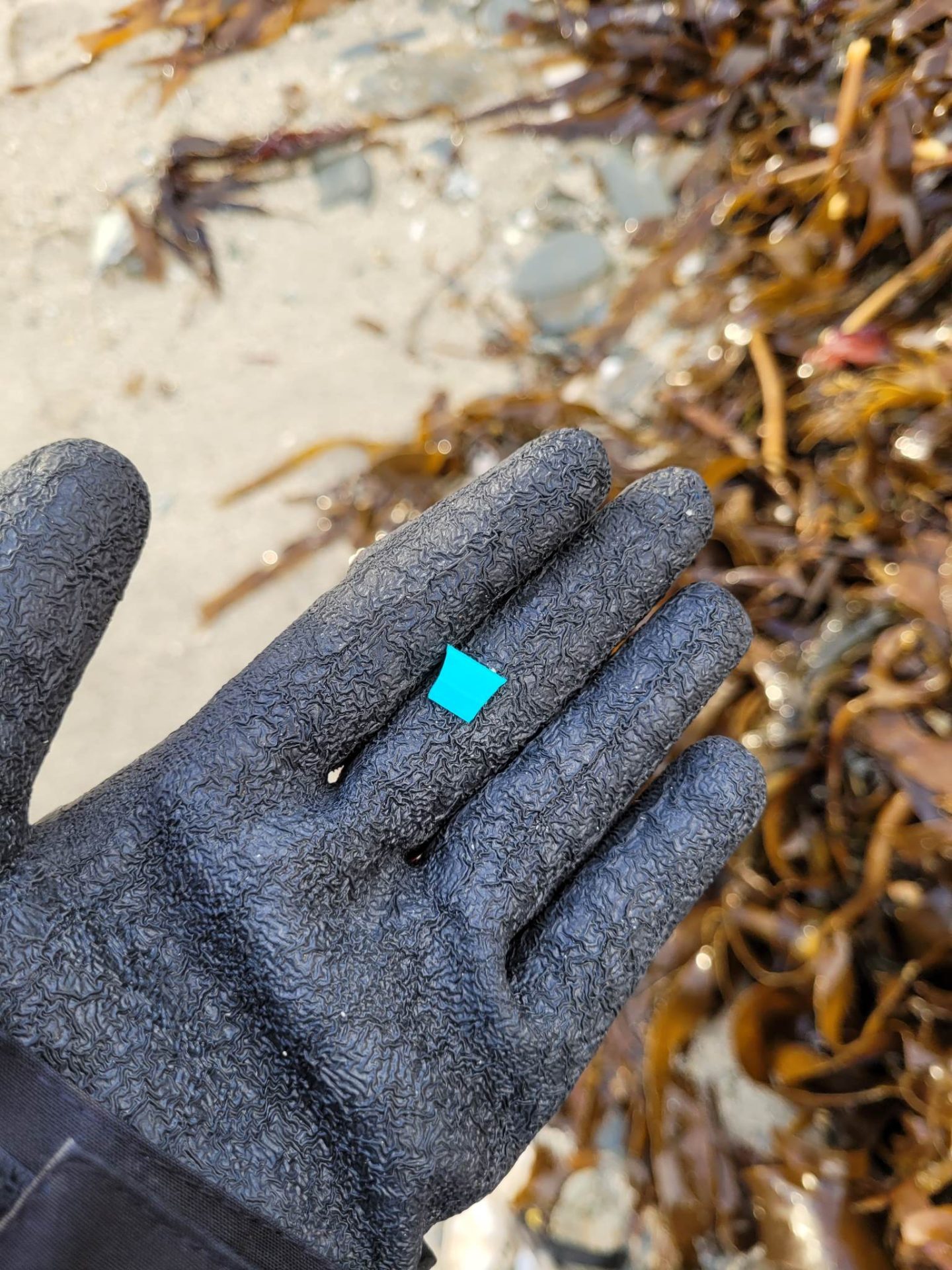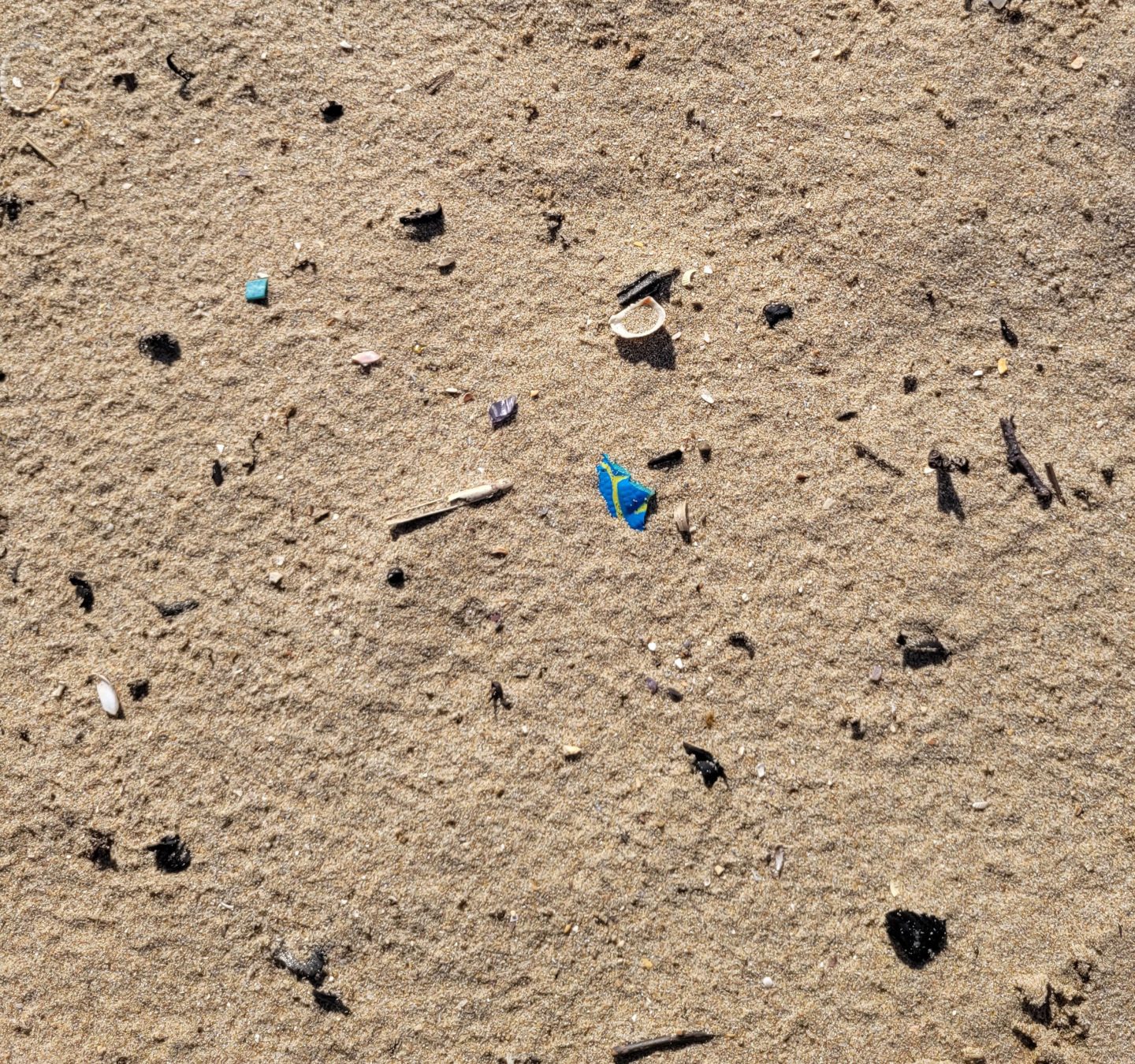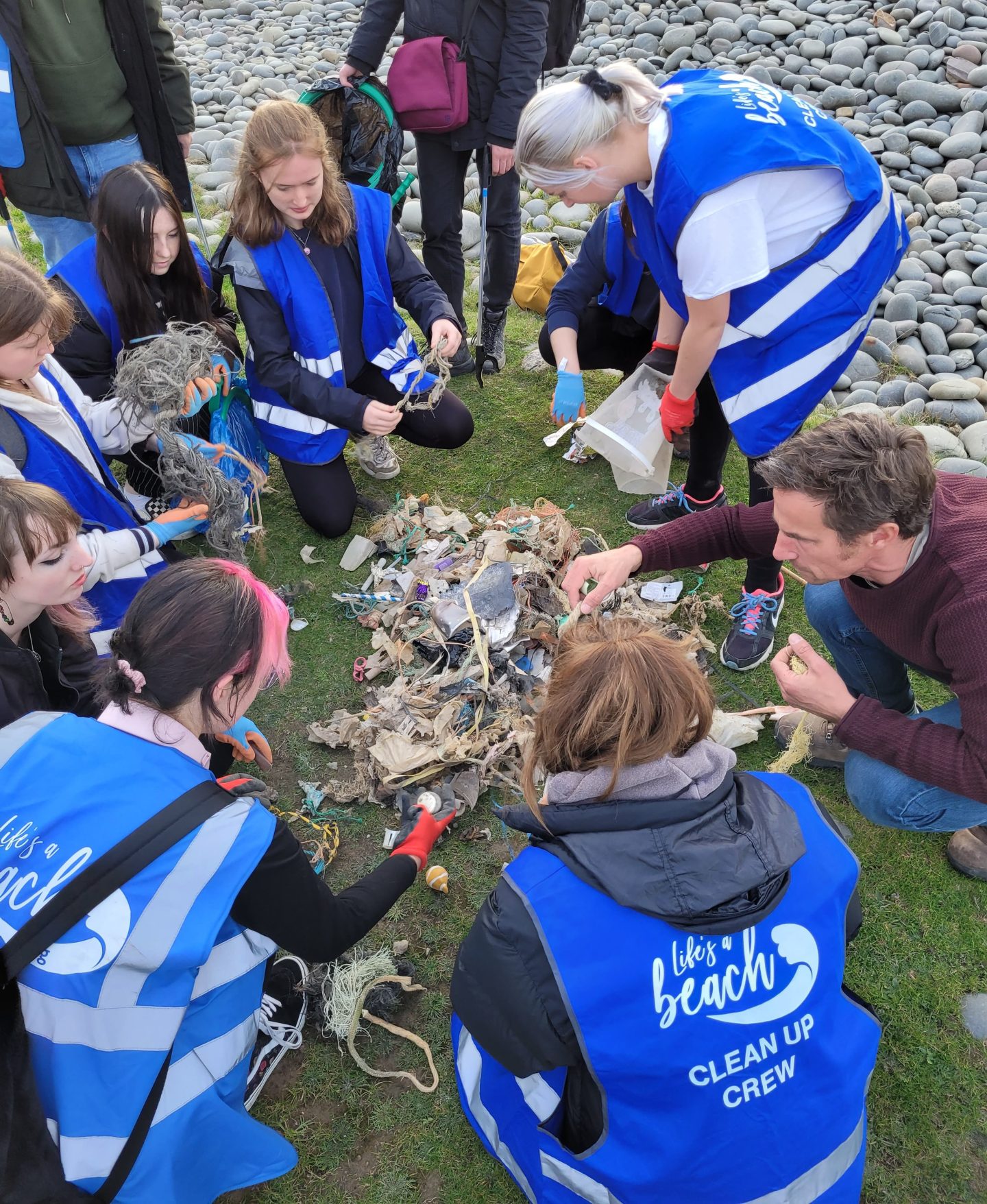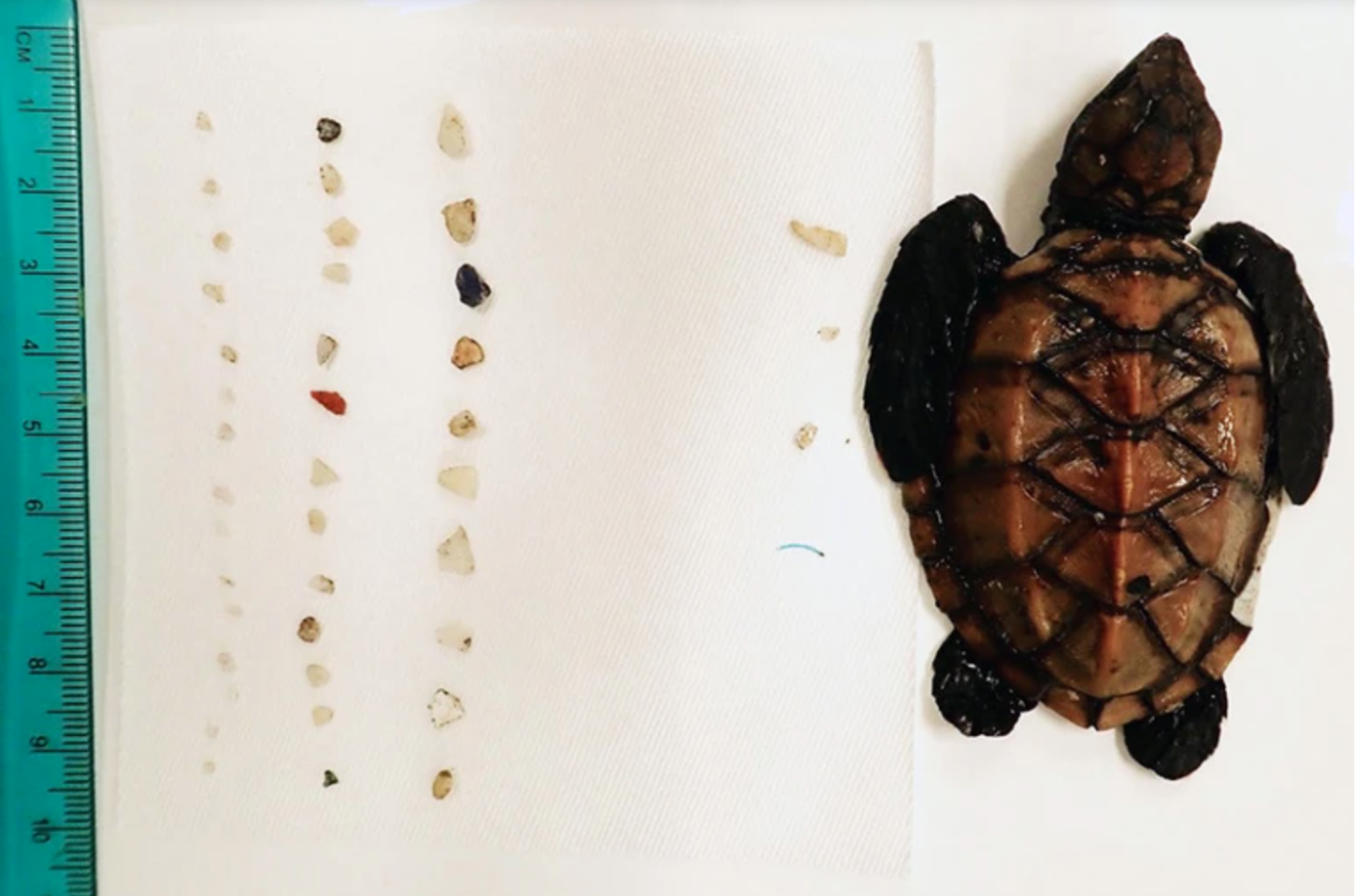

What are microplastics?
Microplastics is a wide term that refers to small plastic particles that are a by-product of plastic waste. This could be fibres, fragments, and spheres that usually, but not always, are formed by the breakdown and deterioration of large items of plastic.
“Microplastics have been defined as particles of plastic < 5 mm in diameter (GESAMP 2015).”
Programme, U.N.E. and Kershaw, D.P.J. (2016) Marine plastic debris and microplastics: Global Lessons and Research to Inspire Action and Guide Policy Change. United Nations Environment Programme.
They can be separated in two main categories, primary and secondary microplastics.
Primary microplastics:
Primary microplastics are plastics that have been made to be small in size in order to perform a specific function. They are things such as small exfoliating beads in toothpaste and skin care products. Another example are ” abrasives in air/ water-blasting to clean the surfaces of buildings and ships’ hulls”. [1] Microbeads are an important type of primary microplastics. Microbeads are plastic resin beads a few millimetres in diameter. They are raw plastic pellets used during the products of plastic items. Sometimes called nurdles.
Secondary microplastics:
Secondary microplastics are fragments of larger plastic items that have been made through weathering and abrasion. A good example of this type of microplastic would be tiny smashed parts of plastic found washed up on beach after weathering a sea. Or, another example would be the plastic fibres from our clothes that are released during washing; or even the synthetic rubber particles kicked into the air and washed away from vehicles tyres during driving. [1]

Why are they an issue and how are they harmful?
When reading about microplastics it can be easy to assume that this is an issue limited to ocean pollution only. This, however, is not the case. Microplastics can be found anywhere where there is plastic. For example, microplastics can be found in landfills where plastic items have been disposed of. We breath in microplastics in heavily insulted buildings and by road sides. So, microplastics not in the marine environment have an impact on human health. However, it is in the ocean that these microplastics are harmful to not just human, but all marine life.
Described as ‘a common concern of humankind’ at the United Nations Environment Assembly in 2014, ocean plastic has an immense ecological impact. While large plastic items (macroplastics) can be damaging to habitats and cause entanglement, microplastics have the more insidious impact. This is due the issue of ingestion.
Sometimes given the nickname of poison-pills, microplastics are a haven for bacteria. Becoming covered in these contaminants, when they are ingested they can cause immense damage. Given the size of microplastics, their rate of ingestion is very high. Numerous marine animals ingest these microplastic such as planktons, corals, seabirds, fish, and marine mammals such as dolphins and whales. These are then passed on in the food chain. Ingesting plastic not only subjects the animals consuming it to the host of bacteria that clings to microplastics, but it also fills their stomach with indigestible material. This then causes the animals to starve.

https://www.nature.com/articles/d41586-021-01143-3
In humans, there is an alarming rise in plastic particles being found in human blood, lungs, even human brains. [2] As stated in the journal, “Microplastics and human health”, while there are still massive gaps in the researched impacts of microplastics on human health, the ingestion and inhalation of of these particles “may be taken up in various organs and might affect health, for example, by damaging cells or inducing inflammatory and immune reactions.”[3]
“a growing body of evidence suggests widespread exposure to microplastics from various foods, drinking water, and air”
Vethaak, A.D. and Legler, J. (2021) “Microplastics and human health,” Science, 371(6530), pp. 672–674. Available at: https://doi.org/10.1126/science.abe5041.
Is it all doom and gloom?
It is undeniable that microplastics are a massive environmental and health issue. We still don’t know the full impact that these pervasive particles are having on our planet and on our bodies. However, despite the enormous amounts of research stating all of the negatives, there are some positives to be taken from this.
New discoveries: New research has suggested that these ocean microplastics may be a good source of new antibiotics. A student-led study conducted in collaboration with the Scripps Institution of Oceanography has stated that “Plastic debris is rich in biomass, and therefore could be a good candidate for antibiotic production, which tends to occur in highly competitive natural environments.” [4] This means that, subject to further research, these plastic particles may hold antibiotics helpful in curing illnesses in the future.
Tackling the issue: As microplastics move into the public focus more and more, people are working hard to try and tackle this growing issue. Across the globe countries are implementing initiatives to ban and reduce plastic waste, and to better recycle plastic in order to prevent ocean contamination. The UN ocean treaty, which aims to scale up ocean protections, is also a great step forward.
New research is being undertaken all the time to better understand not only the impacts of microplastics but how we are deal with the issue. For example, Vinayak Dravid, a materials science and engineering professor at Northwestern University is developing a sponge, original meant for oil spills, that may be an effective way to clean up microplastic particles out of the ocean. [5]

https://education.nationalgeographic.org/resource/microplastics
Conclusion
To conclude, it cannot be avoided, or understated that microplastics are an environmental disaster both to marine life, the oceans, and human health. However, growing public awareness and scientific research means that all hope is not lost! Progress is being made every day to better understand the sources and impacts of microplastics, leading to better strategies on how we can tackle this crisis together. Cutting down on our plastic waste at home and recycling correctly are just some of the ways you can help to tackle this problem directly.
If we all work together, humanity can work together to solve the looming issue of microplastics in our air, and in our oceans.
Sources:
- [1] Programme, U.N.E. and Kershaw, D.P.J. (2016) Marine plastic debris and microplastics: Global Lessons and Research to Inspire Action and Guide Policy Change. United Nations Environment Programme.
- Cox, T. (2018) Microplastic pollution confirmed to be a threat to marine biodiversity, Fauna & Flora International. Available at: https://www.fauna-flora.org/news/microplastic-pollution-confirmed-to-be-a-threat-to-marine-biodiversity/?gclid=CjwKCAiAqt-dBhBcEiwATw-ggHnLoVsu8IfDDZPGfTjNBw7NmeM_lSuBQX5MEnut-r1MKI8rusFfBxoCIU8QAvD_BwE (Accessed: January 6, 2023).
- [2] Microplastic pollution is an alarming threat. we must prevent it. (2022) Sulapac. Available at: https://www.sulapac.com/microplastic/?utm_term=&utm_campaign=Sulapac%2BPerformance%2BMax&utm_source=adwords&utm_medium=ppc&hsa_acc=4234135278&hsa_cam=15924323489&hsa_grp=&hsa_ad=&hsa_src=x&hsa_tgt=&hsa_kw=&hsa_mt=&hsa_net=adwords&hsa_ver=3&gclid=CjwKCAiAqt-dBhBcEiwATw-ggLk40dMzbzsiGiT-pNLISZK_gyUBW4H_Tjv4KFZBzT-oEBRvJxGDwhoCdU0QAvD_BwE (Accessed: January 6, 2023).
- [3] Vethaak, A.D. and Legler, J. (2021) “Microplastics and human health,” Science, 371(6530), pp. 672–674. Available at: https://doi.org/10.1126/science.abe5041.
- Lim, X.Z. (2021) Microplastics are everywhere – but are they harmful?, Nature News. Nature Publishing Group. Available at: https://www.nature.com/articles/d41586-021-01143-3 (Accessed: January 6, 2023).
- [4] Plastic pollution in Ocean may harbor novel antibiotics (15, June 2022) ScienceDaily. ScienceDaily. Available at: http://www.sciencedaily.com/releases/2022/06/220615211327.htm (Accessed: January 6, 2023).
- [5] Peters, A. (April 2022) These sponges can capture microplastics – fast company. Available at: https://www.fastcompany.com/90744494/microplastics-are-everywhere-these-sponges-could-help-capture-them (Accessed: January 6, 2023).
- 2022 UN Ocean Conference (no date) United Nations. United Nations. Available at: https://www.un.org/en/conferences/ocean2022 (Accessed: January 6, 2023).
- Microplastics (no date) National Geographic Society. National Geographic Society. Available at: https://education.nationalgeographic.org/resource/microplastics (Accessed: January 6, 2023).
